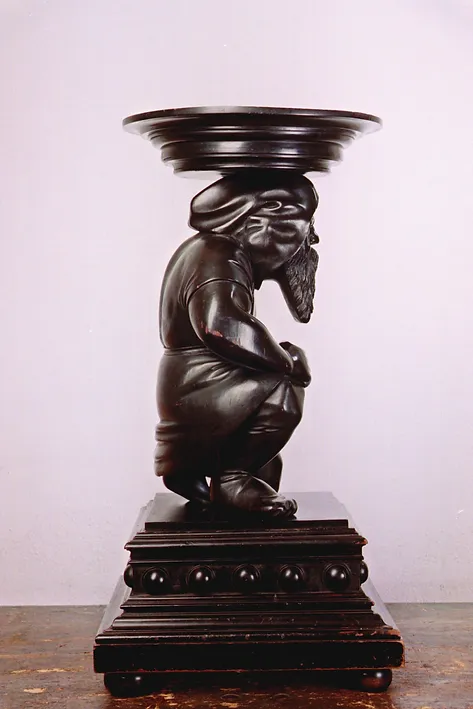
When I came into contact with this impressive sculpture of Atlas in October 1989 which is formed as a column (telamon) I had the privilege of immediate observers on all sides of the sculpture. Because of its unusual style and perceived body disproportions I wanted to discover the name of the unknown artist who created the work, not thinking that this insight would come after many years of research, and I tried to avoid the name of the artist, which kept coming up, in disbelief, which over time was overcome by the strength of the qualified arguments.

Leonardo accepted the Ptolemean cosmological idea of the world, according to which the nature of every planet consisted of four cosmic elements: earth, water, air and fire, which were located in four concentric spheres, with the earth in the centre, as the heaviest, followed by the spheres of water, air and fire.
The geometrical image of the four elements that comprise the world is formed with mathematical precision in this sculpture of Atlas, as for example the element of earth, parallel to the interpretation of the geological layers of the Earth which are presented in a particular manner using an arithmetical method for doubling the cube, according to Codice Atlantico, fol. 58r (1504). The element of water is emphasized not only in the way the sculpture is formed, but also by the symbolic position of the body, which forms an equilateral triangle, relating to a flat surface, whereby we are able to construct Plato’s icosahedra, which symbolizes water, whilst we can recognize the element of air through the interpretation of breathing, seen in the four characteristic changes the sea undergoes, that is, high and low tides, which cause the surface of the water to be wavy, which has a key role in the formation of the sculpture of Atlas, as it is formed according to the reflection of a body on the wavy surface of water. Finally we should mentioned the element of fire, which we find in the construction of the mono-ocular pyramid of light on the sculpture of Atlas, as the observer of the reflected image of the Sun or the Moon on the wavy surface of water, although the pyramid, like the element of fire, is formed by the sculpture of Atlas itself in a specific geometrical manner.

Leonardo da Vinci tended to mingle art and science with extreme mathematical precision throughout his entire artistic opus. This assumption was the starting point for the attribution of this ingenious sculpture of Atlas, which is formed as a column (telamon), from alder wood (alnus), and it is founded on multi-discipline scientific research. Numbers as a measure of beauty are central in the graphic presentation of this research, not only in relation to the use of the divine proportion in the formation of the sculpture, but primarily in relation to the laws of morphological forms, optics and astronomy. The grotesque sculpture of Atlas is formed on the basis of the reflection of a body in the wavy surface of water, as an analogy for the reflection of the body in a semi-cylindrical shaped mirror, in order to represent the fact that the nature of the Moon is similar to the nature of the Earth. The way the sculpture is formed is almost axiomatically linked with Leonardo’s scientific thought in the fields of optics and astronomy.

In our research into the formation of the sculpture of Atlas, we find the phenomenon of the formation of the entire world, frozen in a form based on the reflection of a body in the wavy surface of water on which the anamorphic transformation of the giant into a dwarf occurs. If we undertake the reconstruction of the anamorphic image of the sculpture of Atlas in its original shape, in order to identify or recognize the hidden physiognomy of the face, we would perhaps reach an interesting discovery revealing a self-portrait of the artist. His body is like a column standing on a pedestal, as though on the Earth, forming the base of the column, whilst, holding the capital on his head, his in fact holding up the entire world.

The attribution of the grotesque sculpture of Atlas has been undertaken through morphological and comparative analysis of similar sketches and notes in Leonardo’s manuscripts. This piece confirms that those historians were right who tried to characterise Leonardo as a Mannerist, as a mysterious wizard and an unsearchable thinker, who, according to this sculpture, built a new form and style on the basis of optics and astronomy.
*Drasko Dolic: Having completed classical grammar school education, he attained his Master’s degree fromthe University of Zagreb and the academic title Mag. ing. techn. lign. Until 1991 he wasinvolved professionally in interior design and the development of technological productionprocesses.After 1996 he began his research into Leonardo’s art and science, as well as research into thehistory of the development of science in optics and astronomy.The result of that research was the publication of a book, published in English in 2008 under the title “A Study of the Grotesque Sculpture of Atlas”;, and then in 2012 a second expandededition was published, also in English, with the title “The Grotesque Sculpture of Atlas in Relation to Leonardo’s Art and Science”. The initial steps in this research from May 1998 are kept in the catalogued heritage of the eminent expert in Italian Renaissance sculpture, Prof.Dr. Alessandro Parronchi, who supported this research project. And, the last edition of his book from 2017which titled “Leonardo da Vinci: una nuova opera da attribuire al genio del Rinascimento”, published by NePedizioni in Rome.

Share on Facebook

Share on Twitter





kinda like what you published actually. it just is not that easy to find even remotely good stuff to read (you know READ! and not just browsing through it like some uniterested and flesh eating zombie before moving on), so cheers man for not wasting my time!